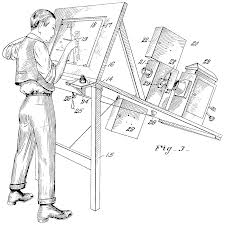Rotoscoping.
What is Rotoscoping? Rotoscoping is where you transfer an image into another film sequence using a rotoscope, typically frame-by-frame.
Rotoscoping was invented by the animator Max Fleischer, who used this technique to animate life-like motions for Koko the Clown from the Out of the Inkwell and Betty Boop cartoons, as well as other characters from the Fleischer cartoons like Betty Boop hula dancing in “Bamboo Isle”, the dancing ghost Walrus from “Minnie the Moocher”, and the titular Old Man of the Mountain, he made some of these animations with his brother Dave Fleischer in the early 1930’s.
The Fleischer’s studio is one of the most effective use of Rotoscoping in their series of action themed superman cartoons.
The productions that helped produce Looney tunes and Merrie Melodies for Warner Bro’s were Leon Schlesinger Productions and they used Rotoscoping on numerous occasions to make these animations, some other productions who use Rotoscoping to make some of their animations are Walt Disney, who are one of the top animation productions that use some of these old techniques in their newer releases, some of their old productions like Snow White and the Seven Dwarfs from 1937 use Rotoscoping, and it was mainly used to learn all about the human and animal movements, not for actual tracing around the animations. Rotoscoping was also extensively used in China, where they first featured a film called “Princess Iron Fan” (1941) and it was released under very difficult conditions during the Second Sino-Japanese War and World War II.
While Rotoscoping is generally known to bring an illusion of realism to a large budget film, the American animation company called Filmation, who are mostly remembered by low-cut limited TV Animation, started to heavily use the technique of Rotoscoping with good effects in series such as Flash Gordon, Blackstar and He-man and the Masters of the Universe.
Not only was Rotoscoping heavily used in animation for film productions and TV Series but it was also used quite a lot in video games like The Last Express, who was designed by Jordan Mechner, who has previously used a lot of this technique in other games such as Prince of Persia and Karateka, and in the modern day, it is used in games like The Walking Dead, it’s a unique video game style that isn’t used as much compared to what it is used in Film and TV productions.
The output of this can have a minor deviation from the lines that differ from frame-to-frame which is caused when the line shakes unnaturally in the animation sequence. Though, sometimes in certain animations the ‘boil’ technique is something that animators aim to do, and this takes a certain skill to internally achieve this as it is a stylistic technique, sometimes used to emphasise the surreal quality of rotoscoping. This was used in the music video “Take on Me”. The very first animated music video was created for a song called “Routine Day” for the band Klaatu and it was rotoscoped by Al Guest and Jean Mathieson. It involved overlapping and dissolving to give a surreal feel to it and feeding It to the ‘boiling’ pencil line. It was also used for a number of other music videos.
Although, Blue and Green screen techniques are still a big thing that is used very often for laying subjects in scenes and creating backgrounds, rotoscoping is still a large factor in the animation industry and is still used very widely in the visual effects of imagery and it has been allowed to be used for special visual effects, for example in the Star Wars films the lightsaber effect was created by a matte base on sticks held by the actors and the editors traced around each frame with the prop and enlarged and added a glow to achieve the effect of the lightsabers glowing. Digital Rotoscop artist is responsible for creating extremely detailed digital mattes, using 2D imagery and processing it using drawing tools. These Mattes are used with wire removals and background fixes, and blue screen extractions.
In the animation industry, there are still a lot of modern day animators who are constantly looking for artists to provide them with rotoscoping techniques, such as Prime Focus, Reliance Media works, Eveqube, Prana Studios, Tata Elxsi Studios and Rhythm n hues.
Here is my own example of what I made for Rotoscoping.


